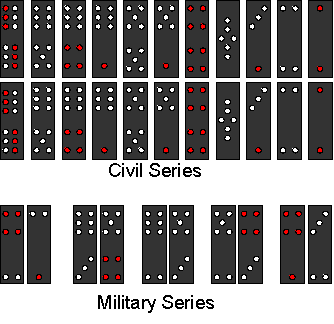Tien Kow
Tien Kow (also known as Tien Gow) is a tile game that uses a set of 32 Chinese dominoes. The Civil series has 11 identical pairs of dominoes while the Military series has 5 mixed pairs. You can make a set of Chinese dominoes by using two sets of normal Western dominoes to make the 11 identical pairs of the Civil series, with the Military series from one of the sets.
Age: Adults and older children
No. of players: 4 players
Equipment: A set of 32 Chinese dominoes. Each player should also start with twenty match sticks or counters for scoring.
Time: 10 minutes+
Aim: The aim of Tien Kow is to score the most points by winning tricks.
The Civil series consists of the six pairs of doubles plus the five pairs of 6:5, 6:4, 6:1, 5:1 and 3:1. The Military series is composed of the following mixed pairs:
- 4:2 and 2:1 (known as the "Supreme pair")
6:3 and 5:4 (the "Mixed nines")
6:2 and 5:3 (the "Mixed eights")
5:2 and 4:3 (the "Mixed sevens")
4:1 and 3:2 (the "Mixed fives")

1. As with most Chinese domino games, Tien Kow starts with the tiles thoroughly mixed and stacked in a "woodpile" (a stack or pile which is eight tiles wide and four tiles high). In the traditional game the "Banker" is chosen by throwing three dice and adding the total number of spots. The players are counted around the table until the counting stops. This player is the Banker for the first round.
2. The Banker deals each player eight dominoes from the woodpile. The Banker then plays the first tile from her hand, with the other three players following in a clockwise direction. The winner of each trick leads the first tile (or pair/s of tiles) for each new trick. A player may lead one tile, or they may choose to lead one or two pairs. Players must follow with a single tile from the same series or must follow with one or two pairs if they are led.
For example, if the Banker leads a 6:1 tile, the other players must play any tile from the Civil series. If they have no Civil series tiles, they must play a Military series tile but it cannot win the trick.
If a player leads with one pair, every other player must also follow by putting down one pair each. If they do not have any pairs, they must discard two unpaired tiles. Likewise, if two pairs are led, the other players must also play two pairs or discard two unmatched tiles.
3. In Tien Kow, the winner of a trick of single tiles is the player with the most spots on their tile from the correct series. The winner of pairs (either one pair or two pairs) is the player with the highest pair according to the following ranking.
- 1. 4:2 and 2:1 (known as the "Supreme pair")
2. 6:6 and 6:6 ("Heaven")
3. 1:1 and 1:1 ("Earth")
4. 4:4 and 4:4 ("Man")
5. 3:1 and 3:1
6. 5:5 and 5:5
7. 3:3 and 3:3
8. 2:2 and 2:2
9. 6:5 and 6:5
10. 6:4 and 6:4
11. 6:1 and 6:1
12. 5:1 and 5:1
13. 6:3 and 5:4 (the "Mixed nines")
14. 6:2 and 5:3 (the "Mixed eights")
15. 5:2 and 4:3 (the "Mixed sevens")
16. 4:1 and 3:2 (the "Mixed fives")
17. 6:6 and either one of the mixed nines
18. 1:1 and one of the mixed eights
19. 4:4 and one of the mixed sevens
20. 3:1 and one of the mixed fives
The winner of the last trick of the round in Tien Kow becomes the Banker for the next round.
4. Scores are calculated after each round.
- a) A player with no tricks pays four points to the winner of the final trick of that round.
b) If the Banker won the final trick, a player with no tricks pays the Banker 8 points. Each time the Banker retains the bank, the number of points paid to the Banker increases by four (12 points for the second round, 16 points for the third, and so on) for any player who does not win any tricks. This resets to 8 points when a different player becomes the Banker.
c) Any player who wins one, two or three tricks deducts that number from four and pays the difference to the winner of the final trick. For example, a player who won three tricks would pay one point (since 4 - 3 = 1)
d) A player with more than four tricks deducts four from the number of tricks and receives that number of points from the winner of the final trick. For example, a player who won six tricks would receive two points (since 6 - 4 = 2)
e) If the Banker leads the Supreme pair (4:2 and 2:1), she claims four points each from every other player.
f) If the another player leads the Supreme pair (4:2 and 2:1), he claims four points from the Banker and two points each from the other two players.
g) The Banker claims 8 points from each of the other players if she leads any one of the following pairs - 6:6/6:3 or 6:6/5:4 or 1:1/6:2 or 1:1/5:3 or 4:4/5:2 or 4:4/4:3 or 3:1/4:1 or 3:1/3:2
h) If another player leads any of the pairs listed in g) above, they claim 8 points from the Banker and 4 points each from the other two players.
5. Play continues for a set time (say 30 minutes) or until one player achieves a certain total score (say 25 points). The overall winner of Tien Kow is the player with the highest score at the end of the game.
| Click on the links below for more Worldwide Games such as ... |
|
Do you have a favourite Worldwide game that you want to share with all our readers? You can share YOUR Worldwide game and/or check out other readers' favourite Worldwide games. It's easy! Just click on this share YOUR Worldwide game link and follow the instructions. |
Thank you for visiting our website!
Parlor Games | Board Games | Traveling Games | Tile (Domino) Games
Card Games | Worldwide Games | Outdoor Games | Dice Games | Word Games
Christmas Games | Easter Games | Thanksgiving Games
Family Reunion Games | Valentines Games





